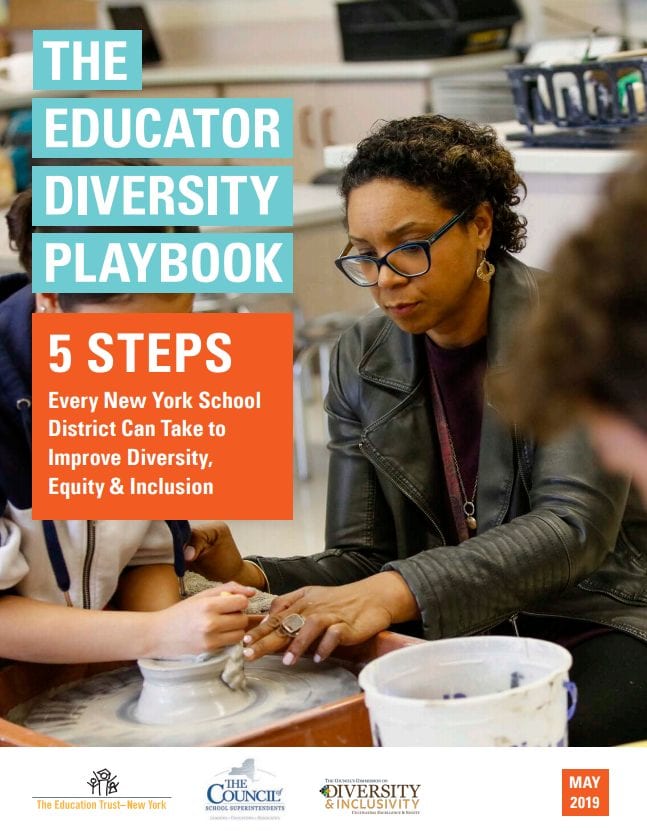The Educator Diversity Playbook offers strategies and examples of how school districts can recruit, support, and retain educators of color
NEW YORK – The Education Trust–New York, The New York State Council of School Superintendents, and the Council’s Commission on Diversity & Inclusivity today released the Educator Diversity Playbook, a tool for school district leaders to improve educator diversity, equity, and inclusion in their schools and central offices.
The Playbook — available online at www.seeourtruth.org/playbook — focuses on five practical steps that school districts can take to cultivate a more diverse workforce:
- Encourage school boards to signal and embrace the importance of teacher and school leader diversity.
- Collect and use data to examine school district recruitment, interview, and hiring practices.
- Question and change recruitment practices to identify additional qualified applicants of color.
- Improve the working environment for educators of color.
- Invest in mentorship and career ladders for current and aspiring teacher, school, and district leaders.
For each of these steps, the Playbook briefly cites the research, offers a district policy checklist, recommends indicators to track, and describes examples of New York school districts that are taking on this important work.
“When we listen to students, teachers, school and district leaders — and the research — it is clear that all students deserve to be taught by educators who are well-prepared, supported, and diverse,” said Ian Rosenblum, Executive Director of The Education Trust–New York. “School districts across New York are recognizing this and actively working to improve educator diversity, equity, and inclusion, and we hope this Playbook serves as a useful tool to help them make progress.”
“The new Playbook provides a much-needed road map for moving from talk to action in opening the pipeline to increase diversity among the educators working in our schools,” said Dr. Lorna Lewis, President of the New York State Council of School Superintendents and Superintendent of the Plainview-Old Bethpage Central School District. “Our schools should mirror the world around us. Children of all shades need to experience the richness that diversity brings in preparing them for the realities of their future.”
“Increasing the diversity of our education professionals must be a top priority for all school districts,” said Dr. Luvelle Brown, Co-Chairperson of the NYSCOSS Commission on Diversity and Inclusivity and Superintendent of the Ithaca City School District. “The recently released Educator Diversity Playbook provides an effective road map to address a pressing challenge.”
“Public education must be transforming and transcending for all students, taking them from where they are to where they ought to be and lending to the expansion of their cognitive horizons and watermarks for success,” said Dr. L. Oliver Robinson, Co-Chairperson of the NYSCOSS Commission on Diversity and Inclusivity and Superintendent of the Shenendehowa Central School District. “We must intentionally disrupt and change current policies and practices, lending to equity in opportunities and outcomes.”
Across New York State and around the country, increasing the diversity of the educator workforce is attracting attention and gaining momentum.
At the same time, we also know that New York has a long way to go to ensure that all students have access to strong and diverse educators. According to data released by Ed Trust–NY, one-third of all New York schools had no Latino or Black teachers in the 2015-16 school year. As a result, more than 115,000 Latino and Black students were enrolled in schools without a single full-time same-race/ethnicity teacher, and nearly half of the state’s White students attended schools without a single full-time Latino or Black teacher.
Yet there are also bright spots across the state—school districts working hard to create a diverse, equitable, and inclusive environment for educators and students alike, including:
- Ithaca City School District Superintendent Luvelle Brown and the school board have made increasing staff diversity one of the goals in their strategic plan. Board members also play a hands-on role in teacher improvement and retention efforts. Read more here.
- In the Schenectady City School District, Superintendent Larry Spring says the goal is not just to develop a more diverse staff but for the community to understand why that is a goal. Read more here.
- Buffalo Public Schools Superintendent Kriner Cash continues to recruit educators of color by welcoming college and university education students into the district’s classrooms before they finish their teacher preparation program. Read more here.
- Valley Stream 13 School District on Long Island is focused not just on recruiting applicants of color but supporting them throughout the hiring process. Administrators have worked over the past several years to identify practices in the hiring process that create barriers to hiring diverse candidates. Read more here.
- In Shenendehowa Central Schools, educators combat bias and promote inclusivity from the moment a candidate of color interviews for a job to the moment that teacher retires. The district made an anti-bias hiring video that all hiring committees watch before interviewing job candidates. Read more here.
- The New York City Department of Education’s NYC Men Teach program aims to increase the number of men of color in city classrooms by engaging, recruiting, and supporting candidates from before they enter the field through their careers in the classroom. Read more here.
These examples remind us that in addition to seeking state-level policy changes and investments to support a more diverse educator workforce, there are powerful and practical steps that individual school districts and district leaders can take right now in their local communities.
Please visit www.seeourtruth.org/playbook for additional information.


